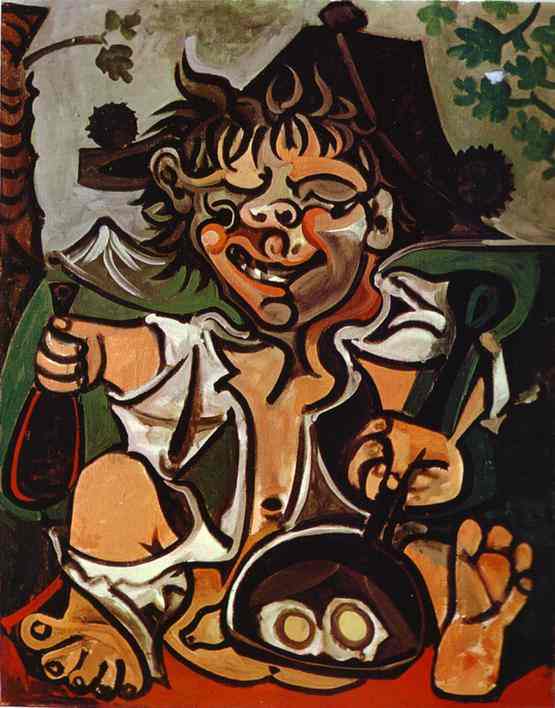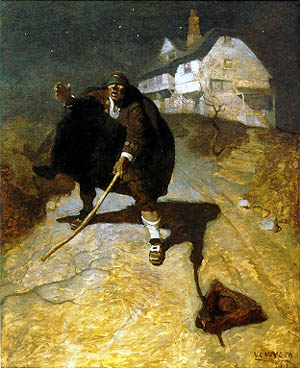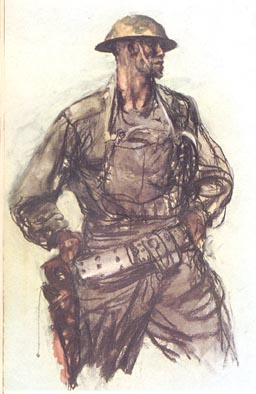
Posted on 07/04/2005 9:08:03 AM PDT by vannrox
The article follows...
Hi everybody.
Have been following the Commercial art=Bad art thread for a couple of days and wanted to throw in my two cents.
On the topic of 'commercial illustration=bad art' and Rockwell, Parrish, and N. C. Wyeth, et al. be damned: I can't say I agree. If one has to say that the damning detail of the art was the fact that Rockwell had to accept guidelines as to what he was to paint (i.e. paint Santa having milk and cookies for our December issue of The Saturday Evening Post) so then his art isn't art, but crass commercialism posing as art, I'd have to say:
Um, how is that different from Michelangelo painting the Sistine Chapel as per the Pope's orders? Or any religious painting/altar piece commissioned by the Church? Or any number of portraits commissioned by the sitters? Why is Velázquez' painting of Pope Innocent X (IIRC) fine or high art and Maxfield Parrish's Ecstasy not? Or that famous painting by N. C. Wyeth of Robin Hood (with his men) coming out of the underbrush of Sherwood Forest, with Robin in the lead wearing a pensive expression on his face (sorry can't recall the title, mea culpa) -- how is that less fine art than Waterhouse's Lady of Shalott? Both illustrate a literary moment. That Wyeth produced that painting to be an illustration for a book doesn't debase it in my eyes any more than finding Lady of Shalott reproduced on a canvas tote bag. Is it merely that one artist's work was produced on canvas to be hung on the museum or salon wall as opposed to being done on canvas to be mass-reproduced by the publishing industry the point on which this argument is being made, here??
All these artists made their paintings/artwork for money -- they made them and expected to be paid for them. That is how they earned their living. To denigrate one group because the fruits of their labors were reproduced as product labels, calendars, advertising one-sheets, or magazine covers as opposed to museum and salon pieces is stupid, really. Not all commerical artists and illustrators were on the level of sheer beauty and mastery of the medium as Parrish or Wyeth, Pyle or Beardsley. There were, and still are, lots of drekky kludge being marketed as advertising and illustration and fine art. But a gem is a gem, whether set in precious metal or mud. Drekky kludge was made in Leighton's day, as well as Parrish's, as well as our own.
Do you think that the poster of this argument simply bought the Modern Art argument that commercialism is just "bad", that good art must be made without thought of material gain, that the artist is virtuous if he or she did not "sell out" to the "Establishment" for "money"? Well, hell. How is an artist gonna pay the rent, much less buy more paint if he or she doesn't "sell"? There's a theme here ... In the 19th c., there were highly paid and sought after engravers -- Gustave Doré, for example -- who were adored by the public and paid well for their efforts. Well, how is that different from Alma-Tadema's work or Leighton's work being reproduced in half-tone or engraving in the periodicals of their hey-day? Or, get this, of either of those artists making copies of their popular works in oil on canvas for other clients? Bouguereau did this. Leonardo da Vinci did his Madonna of the Rocks at least twice, that I know of. Yet no one is bashing him. Why? Is it mass production of copies/images of the works the no-no, then? No one seems to be disputing their merit today, amongst the goodart group.
Yet, how is it that the illustrators of the "Golden Age", a period spanning a decade prior to 1900, if I recall correctly, to about the 1920s/early 30s (Parrish's heyday) are disparaged? I see the whole "Golden Age of Illustration" to be the refugee camp for fine artists of the Old School, artists who managed to make a fine living practicing the skills and turning out the product that they'd trained long and hard for which galleries and salons were no longer willing to accept into their hallowed halls -- having had their collective heads turned by the modernist crap as the "Next Big Thing." And that's just the "Golden Age" greats I'm talking about here, BTW. I haven't gone on to name any number of really great cover artists seen gracing the covers of books at the local bookstore -- much less discussing artists in any single genre of books in said bookstore. (Not to mention the fact that cover art is becoming less a painted piece of work and more a matter of digital sampling cobbled together into a .... but I digress.)
Instead of bashing advertising and commerical efforts as a degrading influence on these illustrator "Greats", don't you think that we should be thankful that the businesses in question gave these artists an outlet, a venue for their talent? What about all of Diego Rivera's murals for the great American industrialists in the 30s? Wasn't he commissioned by Edsel Ford to do a series of murals that came to be called the Detroit Series? What about those?
If it's not patronage by industrialists from being great artists, is it the fact that these artists worked for the print media that disqualify these illustrators their place in the sun of our good regard? If so, why? Given the mass production of the medium (magazines, free calendars, etc.) many many more people were exposed to art well done, than could ever hope to afford a trip to a museum. Especially in Parrish's case, as a good portion of his life's work was done during the Depression years. That should count for something, shouldn't it?
In fact, there was one period when he would unveil a painting every so often in the store window of his client -- I can't recall now if it was a department store chain or a drugstore -- in New York/major Northern metropolis, and people from all walks of life would line up for blocks to see it. Men, women and children. All ages. All weathers. It was often the bright point in their week, month, life. How could something that gave such joy and contentment to so many be denigrated as "crass commercialism/bad art"? Furthermore, when his work, Sunrise, was displayed, the lines broke all records. There was vast hue and cry some years later when it was reported lost and missing, suspected stolen. It finally turned up in the 70s, at an auction house, if I remember correctly. In case you're interested, the info here on Parrish came from a recently published book (c. 2001 or so), written by a woman who worked with one of the big auction houses up north, and was closely tied to the Parrish family. Dang, I should have bought it. I could then better phrase my argument.
Anyway, that's the best I can put this, given the lateness of the hour and some throat-clearing from my spouse to turn the darn thing off and turn out the lights ....
Maer
An excellent and impassioned argument for illustration as a venue being anything but mutually exclusive with great fine art. Rembrandt's greatest works illustrate the bible, and Michelangelo's greatest works of all, his David and Moses, both are based on biblical stories. The greatest works of the pre-Raphaelites come from myth and legend.
In fact it's the nature of stories and storytelling that needs to be properly analyzed as in fact wholly consistent and not in any way mutually exclusive with the concept and goals of fine painting and sculpture. Fine art first and foremost is about humanity and the human condition, as is all the greatest literature. The two go hand in glove, and to the extent that stories embody the most profound and powerful elements in what it means to be alive as a human being, they are in fact the perfect vehicle for the finest fine art that has ever been produced. Certainly genre and scenes from life's adventure that are generalized, like: Hope, fear, love, greed, death, youth, aging, and searching for one's identity, are all embodied in endless works of literature, and painting is a unique medium for expressing such things outside of a specific story of context. But this is extraordinarily important in the quest of redefining the debate in today's art world, and I will see about posting this commentary by Mary as well as other's that have been written on this subject ...
Thanks,
Fred


was commissioned by the father of the boy. When Gainsborough painted a dog if the right, lower corner, the father complained that he paid for a picture of his son...not a picture of a dog. With that, Gainsborough "edited" the picture.
I guess that this makes this commissioned work "NOT art"?
There is an art to avoiding vecksome individuals who seek to categorize the world of creative expression in terms of whether it is art or not. However, describing it violates a longstanding practise of avoiding things that are always better left unsaid.
OhMyGawd! Did I violate a law about which I was unaware?
;-)
May I say that Rockwell is one of my very-most favorite authors?
Per Red Green: "If I can do it, It ain't art."
That sounds suspiciously like something from "Through the Looking Glass"...where most of the notions from the art world propagate.
It gives rise to the fiction that certain individuals are "divinely appointed by the Creator" to be "true Artistes"...
if that isn't bad enough,it also has a corollary that everyone else are slack-jawed nobodies...the rough equivalent of little miserable turds appearing in the church collection basket.
I could not agree with Ross more. The greatest art is about the human condition, and I think the deeper this content, the finer the work of art. I don't think it matters, always, whether the creator is an illustrator or not. And it doesn't matter who's paying for the piece. What matters is the depth of expression.
Most "fine" artists, like Picasso, have produced some pretty poor pieces, and some illustrators like Rockwell have produced some very fine pieces.
Some might argue that a great deal of the "quality" is derived from how the paint has been applied. Rockwell did not do a great deal with his "surfaces." But art's quality should not be limited to surface texture.
Some works to illustrate my points. I've seen Hunt's Lady of Shallot and it's stunning.


William Holman Hunt Lady of Shallot and John William Waterhouse Lady of Shallot
These are affecting images. The second one I found in a search for the first one, but I also like it.
Even I, who loves abstraction, have to admit that this Picasso is less affecting than the other images above, although others may disagree.

I think a great deal of the "quality" has to do with the depth of the image. Sometimes illustrators deal with a single moment or image or gag, and it doesn't go much deeper than that. Rockwell, in his Four Freedoms, did go deeper, partly because of his profoundly patriotic inspiration. (Here's one of his studies for Freedom of Speech.) But other images seem more clever and humorous and less deep, as in his Sixth Inning below.


Whereas Michelangelo is always powerful because he is always dealing with the essential struggles of life, even in little details on the Sistine Chapel, as in Ezekial below.

Art ping.
Let Sam Cree or I know if you want on or off the art ping list.
Words to live by.


I think my favorite is still N.C. Wyeth, despite Rockwell's tremendous talent I think Wyeth had more breadth of imagination and a stronger sense of form.


Treasure Island

Kidnapped

Robin Hood

For sheer drama and overall uniform quality, you can't beat his illustrations for Treasure Island. But lots of others are great too -- that last one is a portrait of the carpetbaggers from the Pike County Ballads - an o.k. book redeemed by splendid illustrations.
Thanks for the ping bump.
He is definitely having some fried huevos.

J.M. Flagg

John Held

Charles Dana Gibson

Antonio Vargas
He also did some nifty, deliberately antique woodcuts, disguised social commentary, sort of like Dicky Doyle's ye customes of ye Englishe in 1842.

Other forgotten masters:


Harvey Dunn, in war and peace

A.B. Frost

Rockwell Kent (even if he WAS a Commie).
"Clever" modern artists hang an everyday store item (bicycle seat, urinal, et al) on a gallery wall and proclaim it "art". You can bet that they charge far more than the retail value of the materials.
The art world's disdain for illustrator artwork is similar to their long refusal to accept photography as "art". That changed after decades.
Is there any difference between someone who drew/painted illustrations for magazines rather than 17th century books? Does it matter if the artwork was commissioned by the publisher or an advertiser? What if it is "comic" rather than serious?
The art world DOES recognize self-taught "primitive" artists. In the past they may have been called "amateurs".
Dali was even willing to recognize the work of someone who painted a door or room well more than he was willing to react in awe at "modern art". Brush control was important to him (at least when he wrote his book on modern art).
Disclaimer: Opinions posted on Free Republic are those of the individual posters and do not necessarily represent the opinion of Free Republic or its management. All materials posted herein are protected by copyright law and the exemption for fair use of copyrighted works.